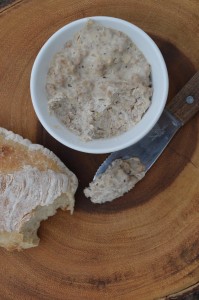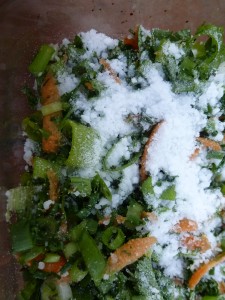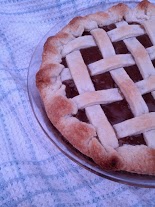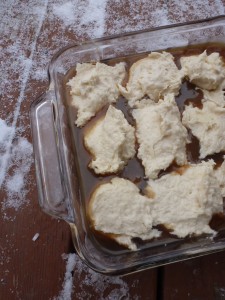Originally posted December 15, 2009 (if you can believe that). Re-posted today with some major corrections. I first read about cretons in an article in The Ottawa Citizen by then-food-columnist Ron Eade. He presented cretons as a Quebecois variation on rillette. A while back Emmanuel (Manu) of Pied Cochon, Joe Beef, and Woodwork fame gave me the skinny on cretons, and they really are not like rillettes at all. I am not able to find that original Ron Eade article to expose it. Presumably someone from the lower St. Lawrence forced him to remove it as libel or lies. Anyways.
 Cretons is a pork spread made by simmering ground pork and aromatics like onion, bay, and clove in milk or … Continue reading.
Cretons is a pork spread made by simmering ground pork and aromatics like onion, bay, and clove in milk or … Continue reading.
 Tourtière is made differently in every home, and can incite intense feelings of loyalty to ones mother. I will proceed cautiously with a definition, but I warn you: there are lots of qualifiers in this post.
Tourtière is made differently in every home, and can incite intense feelings of loyalty to ones mother. I will proceed cautiously with a definition, but I warn you: there are lots of qualifiers in this post.
Tourtière is meat pie. It is often based on pork, though veal and game are also common. If anyone tells you that it was traditionally made with pigeon, you can politely dismiss their story as folklore. A false etymology has developed because of the similarity between the words for the pie tourtière and the Quebecois word for the now-extinct passenger pigeon, tourte. Certainly many a pigeon has been baked into pie, but the similarity between the two words is entirely coincidental. Tourte also … Continue reading.
 Last year I wrote that ham hocks are only consumed in one of two ways in my house: either slowly roasted so that they have glassy crackling, or simmered so that their intense, smoky, porky essence can be collected in a broth.
Last year I wrote that ham hocks are only consumed in one of two ways in my house: either slowly roasted so that they have glassy crackling, or simmered so that their intense, smoky, porky essence can be collected in a broth.
This ham-hock broth is the distilled essence of eastern Canada, and the foundation of split-pea soup.
Once you have simmered the ham hock and collected the broth, here are some thoughts on making split-pea soup.
After extensive cooking the ham hock itself has very little flavour and seasoning, but it still makes for a good garnish.
I use yellow split-peas, because the green ones look like baby poo once they’re cooked.
Split-peas have very intense thickening power. In … Continue reading.
 This is a very old-school Québécois way to preserve herbs, onions, carrots… really any manner of aromatic vegetable. They are chopped finely, mixed with salt, left in the fridge for a week, then transferred to a jar. That’s it.
This is a very old-school Québécois way to preserve herbs, onions, carrots… really any manner of aromatic vegetable. They are chopped finely, mixed with salt, left in the fridge for a week, then transferred to a jar. That’s it.
Ingredients. It would be silly to offer a “recipe” as such for herbes salées. You shouldn’t go to a grocery store and buy a set of ingredients; you should use whatever you have in abundance in your herb garden in the late season. There are, however, some useful ratios to keep in mind.
1 part salt for every 3 parts aromatics, by weight. In other words 33 g of salt for every 100 g of herb mix.
In terms … Continue reading.
I have a certain old friend. Technically we went to high school together, but I first got to know him in Lister Hall, then at the Kappa Alpha house on university row. He studied philosophy, and after graduation he followed a girl to Montreal. There he fell victim to many of the city’s seductions: strong beer, girls, and cocaine, yes, but above all these, smoked meat.
For a while he lived only a few blocks from Schwartz’s, that Mecca of Montreal smoked meat. For a while he ate there every day: a sandwich, a pickle, and a cherry coke.
Montreal smoked meat is that city’s answer to New York’s pastrami: beef, cured with a concoction of spices similar to those … Continue reading.
 If you are unfamiliar with this dish, let me introduce you by way of an aimless personal anecdote. If you are familiar with the dish, you can skip the next paragraph.
If you are unfamiliar with this dish, let me introduce you by way of an aimless personal anecdote. If you are familiar with the dish, you can skip the next paragraph.
My father’s family lives near Ottawa, my mother’s near Sudbury. When I was little my family would sometimes drive between these two sets of relatives, following the Ottawa River valley, where there are lots of French communities, even on the Ontarian side of the border. Along the way we would always stop at a diner called Valois in the French town of Mattawa. For dessert they offered “sugar pie,” a tidy translation of tarte au sucre. While some versions of sugar pie are made with corn syrup or … Continue reading.
My mom has prepared a yule log cake every Christmas I can remember. I have no idea how this tradition came to my family, as it is extremely French (“bûche de noël”), and we are not.
The cake is a simple sponge. Whole eggs are beaten thoroughly, sugar is added, then a bit of water, and finally flour and cocoa are folded in. The batter is runny, and forms a shallow, uniform, fine-textured cake after baking.
The interior icing is a buttercream made by whipping room-temperature butter into Swiss meringue. Swiss meringue is a mixture of whipped egg whites and simple syrup cooked to soft ball stage.
The exterior frosting is icing sugar beaten into lard, which makes the colour … Continue reading.
Winter Food
Throughout late summer I found myself craving winter food. When I was filling my rumpot with fruit and canning my sauerkraut it was twenty degrees outside, but I was thinking of the dead of winter, and the rich, warming, comforting food I would enjoy.
Preservation of food has become central to my idea of local cuisine. I’ve always included meat in my concept of preserving for the impending winter, but I recently realized that this doesn’t make much sense.
Before refrigeration, fresh meat could only be kept in the winter. Of course you could kill a chicken in the summer and eat it for dinner, but what if you were to kill a cow and not have a … Continue reading.

 My dad grew up in eastern Ontario, in sugar shack country. The most common applications of maple syrup in his home were pouring over pumpkin pie and cornbread, or, if he was especially well-behaved, as a dip for white bread. These dishes win for most direct conveyance of syrup to mouth without drinking from the bottle, but I need something (slightly) more refined.
My dad grew up in eastern Ontario, in sugar shack country. The most common applications of maple syrup in his home were pouring over pumpkin pie and cornbread, or, if he was especially well-behaved, as a dip for white bread. These dishes win for most direct conveyance of syrup to mouth without drinking from the bottle, but I need something (slightly) more refined.
My Québécois dessert of choice is pouding chômeur. “Chômeur” means unemployed. Here it functions as a substantive, so this is “unemployed person’s pudding.” “Poor man’s pudding” is a more natural sounding translation. Whatever you call it, it’s a fantastic, unadulterated way to enjoy maple syrup.
A simple batter of creamed butter and sugar, eggs, … Continue reading.
The personal website of Edmonton chef Allan Suddaby
 Cretons is a pork spread made by simmering ground pork and aromatics like onion, bay, and clove in milk or … Continue reading.
Cretons is a pork spread made by simmering ground pork and aromatics like onion, bay, and clove in milk or … Continue reading. 

 This is a very old-school Québécois way to preserve herbs, onions, carrots… really any manner of aromatic vegetable. They are chopped finely, mixed with salt, left in the fridge for a week, then transferred to a jar. That’s it.
This is a very old-school Québécois way to preserve herbs, onions, carrots… really any manner of aromatic vegetable. They are chopped finely, mixed with salt, left in the fridge for a week, then transferred to a jar. That’s it.

 My dad grew up in eastern Ontario, in sugar shack country. The most common applications of maple syrup in his home were pouring over pumpkin pie and cornbread, or, if he was especially well-behaved, as a dip for white bread. These dishes win for most direct conveyance of syrup to mouth without drinking from the bottle, but I need something (slightly) more refined.
My dad grew up in eastern Ontario, in sugar shack country. The most common applications of maple syrup in his home were pouring over pumpkin pie and cornbread, or, if he was especially well-behaved, as a dip for white bread. These dishes win for most direct conveyance of syrup to mouth without drinking from the bottle, but I need something (slightly) more refined.